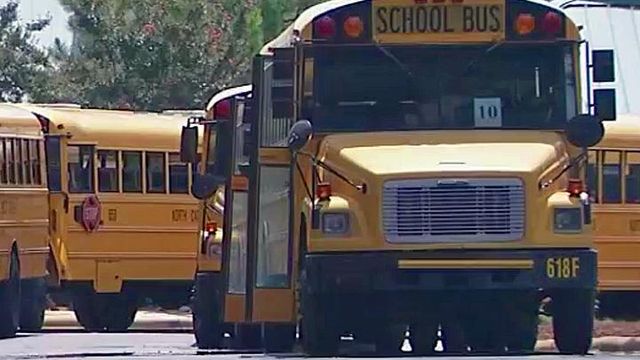Two drivers off the road after children left on Wake buses
Two Wake County school bus drivers were taken off driving duty Wednesday after the school system received reports about two children with special needs being left on their buses after the drivers finished their routes.
Posted — UpdatedThe first case happened last week when an autistic kindergarten student at A.B. Combs Elementary School fell asleep on his bus and the driver did not notice until she was in the middle of a second route.
On Tuesday, a 6-year-old with epilepsy and a sensory processing disorder who attends Salem Elementary School in Apex never got off the bus at his stop in front of his house.
In each case, it took two hours for the boys' parents to be reunited with them.
Michael Charbonneau, a spokesman for the Wake County Public School System, said Wednesday that the school district's policy requires bus drivers to check their buses for children at the end of a route. Those who don't follow the policy, he said, "are held accountable" and "face serious consequences."
"We take any kind of complaint very seriously," he said. "We're going to investigate it fully. The drivers are going to be off the road until it's resolved."
In the first case, Charbonneau said, the driver called her team leader when she noticed the sleeping child, but the team leader, who was also driving a route because of staff shortages, did not answer his phone, per school policy.
Tuesday's case is still under investigation.
Meghann Baynon's son, J.D., was on the bus Tuesday.
She said she waited for him at the bus stop for about 30 minutes before calling her district's transportation office. When they couldn't help her, she said, she called Apex police, fearing something might have happened to her son.
The driver, Baynon said, eventually took him home, apologized and said she was a substitute unfamiliar with the route and was relying on the children to help her. Baynon said the driver told them that she simply did not see the boy, who was sitting in the middle of the bus.
"'I'm sorry' doesn't fix the issue," J.D.'s father, John Baynon, said. "That doesn't fix the problems that led up to that. Something went wrong along the way to allow this to happen."
John Baynon said his concerns go beyond the driver of his son's bus.
He's also concerned about the process in which substitute drivers learn routes and the process of checking the bus for children at the end of the route. He also wants better communication between parents and the school system when such cases occur.
Communication was also an issue in last week's case when Stacey Cochran called the school system's transportation office when his 6-year-old son, Sam, who has autism, didn't get off his bus.
Cochran said he got no answer and when he tried to call another number, he got a message informing him that his call would be returned the next business day.
"I was panic-stricken" Sam's mother, Susan Miller-Cochran said. "We couldn't get in touch with anyone."
Ultimately, she drove her son's bus route, while her husband waited at the stop, and found another bus driver who tried to help her.
It was two hours after he his scheduled 3:35 p.m. bus stop that they were reunited. By that time, Sam was scared, she said, and had soiled his pants.
Generally speaking, Charbonneau said that there are policies and procedures in place that address some of the Baynons' and Cochrans' concerns.
Substitute drivers receive the same training as full-time drivers and also receive a printed route description when they go on an unfamiliar route.
There are also mechanisms in place to ensure that drivers check for children at the end routes. On newer models, there is a button at the back of the bus that drivers must push to deactivate a buzzer. In older buses, drivers must hang a card in the back window to show that they have checked for children.
Charbonneau also said that the school board's vote Tuesday on a plan to reorganize the transportation system should alleviate some of the staff shortages.
• Credits
Copyright 2024 by Capitol Broadcasting Company. All rights reserved. This material may not be published, broadcast, rewritten or redistributed.





